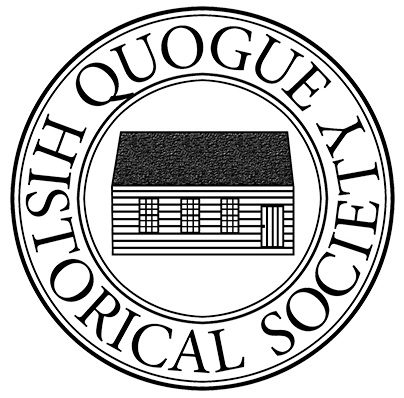History of Quogue
The Quogue Historical Society gratefully acknowledges the Shinnecock people, on whose ancestral lands the village of Quogue was built. Today, the self-governing Shinnecock Nation retains 800 square acres of their original territory in Southampton, New York. The history and culture of the Shinnecock are very much alive.

Early Days of ‘Quawcanantucke’
The early settlers of Southampton, founded in 1640 and the first English colony in the state of New York, quickly realized the value of the broad natural salt marsh meadows near Quogue for grazing their cattle, oxen, swine, and sheep. Also, unlike neighboring villages, Quogue offered direct access to the beach for fishing and whaling.
On May 12, 1659, John Ogden purchased from the Shinnecock tribe a large tract of land that extended from Canoe Place west to Beaver Creek Dam, in what is now Westhampton. The Quogue purchase was the second most important purchase of Native American lands by the English after Southampton.
The deed was signed by Wyandanch, the sachem of the Montauk tribe, and witnessed by Lion Gardiner and his son, David, of Gardiner’s Island, both good friends of Wyandanch.
The sum paid was 400 pounds and the Native Americans retained “… priviledges of fishing fowling hunting or gathering of beryes or any other thing for our vse.”
In the early 1700s, John Foster constructed the first building in Quogue, to accommodate his shepherd. It offered a place to rest, sparing him the long trek back to Southampton. (Miraculously, the building survives today and is a private residence known as Old Revolution. Sheep’s blood has been found on a number of its beams.)
By the mid-18th century, the grandsons of Southampton’s original settlers became the founders of the Quogue settlement. The Post, Foster, Jessup, Herrick, Howell, and Cook families began building homes along Quogue Street.
Life in Quogue in the 18th Century and Early 19th Century
Although no documentation survives of the earliest house or barn in Quogue, the story goes that a date of 1734 was carved over the doorway of John Post’s house on Quogue Street. Also, a regional gazetteer reported, in March 1735, that two little girls were lost in Coagg woods while picking winterberries when a heavy snowstorm began.
Coagg is the earliest record of a single syllable abbreviation from Quawquannantucke,
or Quaquanantuck, which was the Native American name for Quogue.
Other records refer to Quago, Quag, Quoag, Quagga — and, finally, Quogue.
Until the early 19th century, Quogue was a quiet, pastoral community. Each household grew its own food for the table, making ends meet by ocean fishing and whaling, first from the shore, then long ocean voyages.
By the mid-1800s, commercial whaling had become the country’s fifth largest industry as the demand for whale oil as an important source of lighting grew. In Quogue, some families bought shares in the voyages; joined the industry as crew; and a number became captains.
Among them were Henry Gardiner, Frederick M. Hallock, Edward Stevens, and members of the Cooper family. These men made long trips, years at a time, sailing down the Atlantic, around Cape Horn, and into the waters of the Pacific. Many were extremely successful, amassing fortunes and building grand homes along the streets of Quogue.
The Boarding House Era
Lured by cooler temperatures and easy access to glistening white-sand beaches, people have flocked to Quogue in the summer months since 1835. Quogue was the second overnight stagecoach stop on the three-day journey from Brooklyn to Southampton.With the establishment of railroad service to Riverhead, in 1844, “every thrifty and intelligent framer formed the habit of taking in summer boarders for four months of the year.” So wrote Charles H. Barnum, who spent the summer in Quogue, in 1855.
“As a watering place, Quogue stands pre-eminent.
Known as the QUEEN OF THE HAMPTONS, Quogue rules supreme.”
Long Island Railroad Guide, 1877
In 1870, direct rail service to Quogue brought even more summer visitors and, by 1880, Quogue was a bustling summer resort. Thirteen boarding houses and hotels lined Quogue Street and the village flourished.
“Undoubtedly, in proportion to the number of its inhabitants, the wealthiest town in L.I.”
History of Suffolk County, 1882.
By the end of the century, as Quogue’s popularity continued to grow, many families that had summered at its boarding houses and hotels began to build one-family homes — in the now iconic shingle-style — planting lawns, hedges, and shade trees, and transforming Quogue into the charming village we know today. Many of those houses still stand, contributing greatly to the unique character of Quogue.

